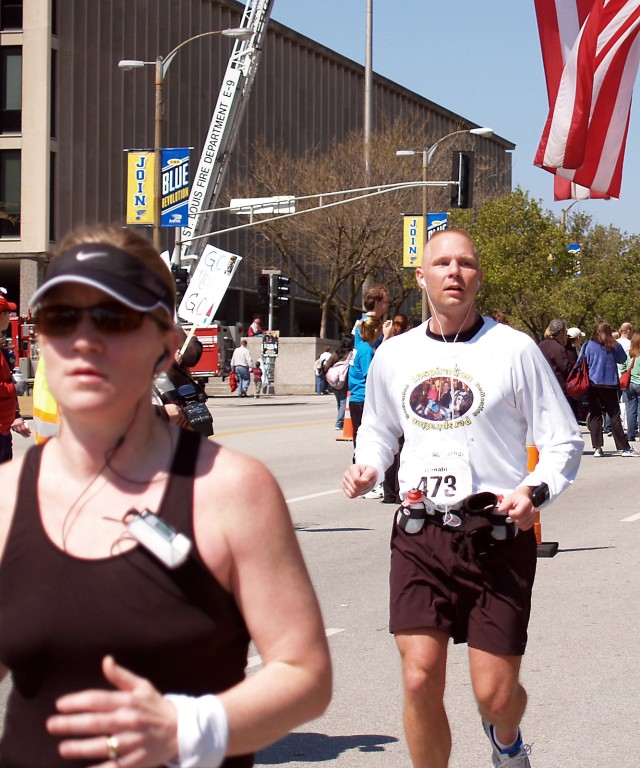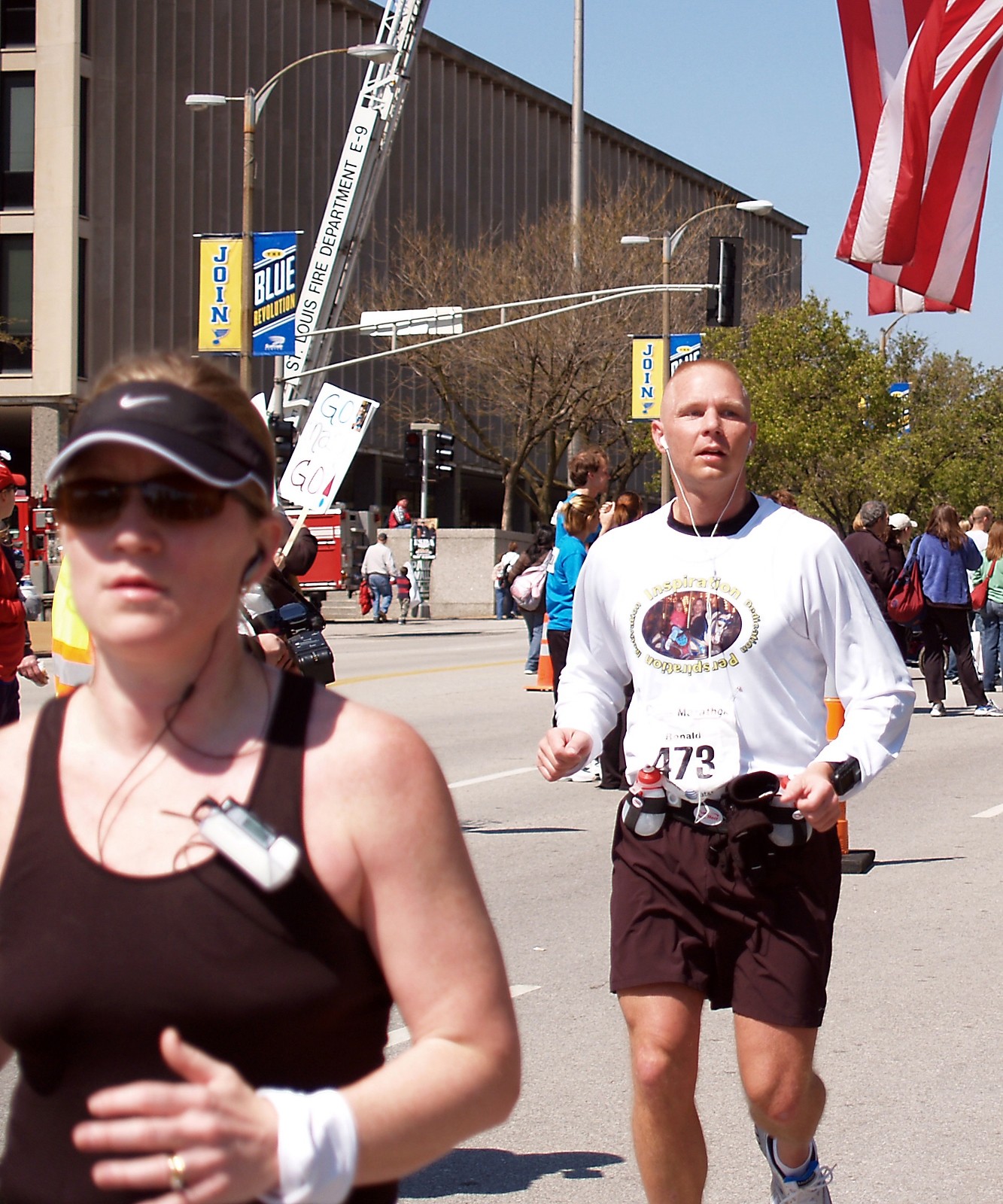FORT LEAVENWORTH, Kan. (Army News Service, April 27, 2007) - It took Command and General Staff College student Maj. Ron Upton four hours, 12 minutes and 48 seconds to complete his first marathon.
To get there, he had to learn to walk again.
In January 2004, Maj. Upton traveled from Fort Leonard Wood, Mo., to St. Louis with some friends to attend a Dallas Stars/St. Louis Blues hockey game. After realizing he left his shaving kit at home, Upton hailed a taxi on the morning of Jan. 25, 2004, with the intent of shopping.
The taxi he was riding in hit some ice, slid off the road and slammed into the side of a building at about 40 mph. After fading in and out of consciousness, Maj. Upton woke up in St. Louis University Hospital with his sixth and seventh cervical vertebrae dislocated. Instead of residing one on top of the other, the vertebrae were side-by-side.
To put him back together, doctors screwed a halo into his cranium and attempted to slide his vertebrae back into place using a pulley system that adds weight in small increments. When that method did not work, two doctors, one at Maj. Upton's head and the other at his feet, pulled and popped his spinal cord back into its correct spot.
"That was a new 10 on my pain scale," Maj. Upton said.
By definition, Maj. Upton was a quadriplegic. He could move his shoulders, but everything below that was non-functional.
"What they told me is that, 'You will never walk again,'" Maj. Upton said.
A surgery fused his vertebrae back together, and doctors inserted eight screws in his neck - four in each effected vertebrae with two rods connecting the screws together. A bone from Maj. Upton's hip was used to fill the gap between the two vertebrae.
"As you can imagine, there's a depression phase here," Maj. Upton said. "Especially those first five days, when I'm in traction with five days of looking at the same spot in the ceiling all day long. It was frustrating."
Hope surfaced on the seventh day in the hospital, one day before Maj. Upton went to the Rehabilitation Institute of St. Louis. While lying in bed, Maj. Upton was trying to figure out a way to "get out of this mess."
He decided to attempt to move his toes when the big toe on his right foot obliged. Although Maj. Upton could not see or feel the movement, his wife, Pam, noticed the wiggle. After prompting him to try again, the toe moved again. She left and returned with a doctor.
"The doctor said, 'That's good, but it's common. Don't get too excited over it but maybe it's something we can work with,'" Maj. Upton recalled.
Excitement and determination set in.
"I probably didn't sleep for the next four days, trying to move other things," he said.
By the time he went to rehab the next day, Maj. Upton was also able to move his ankle.
Little by little, progress was being made, but the uphill battle had just begun. To return to his pre-accident physical state, he would need to relearn all the basic functions he took for granted in everyday life: eating on his own, walking, moving his fingers, going to the bathroom.
Muscle by muscle, Maj. Upton trained his body to remember the actions it had once performed with relative ease.
Maj. Upton said the daily grind was difficult, not only for him but for Pam, too.
"She was a trooper, to sit there every day and watch me and not be able to do much was very tough on her," Maj. Upton said.
Maj. Upton said his battles were more challenging mentally than they were physically or emotionally.
"It wasn't an emotional problem for me, it was mentally tough because I was having to focus all day long for every little task," he said. "You start small and your goals are short."
During his stay at the rehab facility, Maj. Upton was visited by Patrick Rummerfield, who is considered the world's first fully-recovered spinal cord injury quadriplegic. It took Mr. Rummerfield, who was injured in 1974, about 15 years to walk again. After recovering, Mr. Rummerfield became the first quadriplegic to complete a marathon and the first ever to complete a triathlon.
"He came to visit me while I was there and gave me some tips about what to expect and how I was going to feel," Maj. Upton said.
He gained inspiration from the visit and had a promise for Mr. Rummerfield.
"I told him, 'If I walk again, I'm going to run a marathon,'" Maj. Upton said.
But first he would undergo months of physical therapy, tasks that included everything from learning how to feed himself to how to stand. He monitored his progress daily and kept trying to better his previous day's progress, sometimes spending up to 10 hours in the gym.
"You have two options: you can sit in a wheelchair and hurt, or you can do what you love to do and hurt," Maj. Upton said.
He chose the latter.
He stood for the first time eight weeks after the accident. He walked out of the facility on his own accord in April 2004, three-and-a-half months after doctors told him he probably would not walk again.
"You'd be surprised how difficult walking really is," Maj. Upton said.
The road to rehabilitation continued at home, when Maj. Upton returned to Fort Leonard Wood for outpatient therapy.
Progress continued to come in small doses. About two years after the accident, he passed the running portion of the Army Physical Fitness Test. He ran with a friend and passed with time to spare.
"I imagined I would cross the finish line and celebrate," Maj. Upton said. "My wife was there to see it; it was the first test I was taking with the run. I got across the finish line and I collapsed."
In October 2006, Maj. Upton decided to fulfill the promise he made to Mr. Rummerfield months earlier - to run in a marathon. Of all the marathons, he chose the Spirit of St. Louis Marathon, which took place on April 15.
"I think I'm ready to start training, I said I was going to do it, I need to do it, I want to do it - what better place than to go right back where it all started," Maj. Upton said.
In an ironic twist of fate, the marathon route passed the accident site twice and the Rehabilitation Institute of St. Louis twice.
He is pleased with how he ran, but said the race was emotional.
"I was really having a good time, then at mile 23 I got all emotional and I started crying," said Maj. Upton, who recalled the road it took to get to that point.
His ultimate goal, aside from completing the marathon, was to beat the marathon time of four hours, 29 minutes and 20 seconds, set by arguably the most powerful woman in America.
"That was my goal," Maj. Upton said. "If I'm going to run a marathon, I have to beat Oprah." He accomplished that by better than 16 minutes.
Today, Maj. Upton is still on the mend. He deals with chronic nerve pain that he is told will likely stay with him for life. He can't feel temperature on the right side of his body and there are other complications.
But it hasn't stopped him from performing daily tasks.
Following his graduation from CGSC on June 15, Maj. Upton will be stationed at Fort Hood, Texas. In August, his unit will deploy.
On May 6, Maj. Upton will compete in the Big "O" triathlon in Olathe, Kan.
He spends his spare time with his family, including his 14-month-old daughter, who was conceived after the accident.
"I've really been blessed, there's no doubt," Maj. Upton said. "I've had a tremendous amount of support - my wife has been fantastic and, of course, having a baby helps a lot, too, in terms of motivation."
The past few years have been life-changing for Maj. Upton, and the lesson is not lost on him.
"Probably the biggest thing I got out of this is an appreciation for what I do have," Maj. Upton said. "You have to be OK with that, and you may not have the world but you have to learn to be OK with what you do have, appreciate it and not take it for granted."
(Scott Thompson writes for the Fort Leavenworth "Lamp.")


Social Sharing